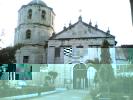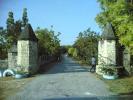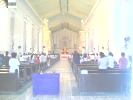| |
|
|
| |
|
VISITS |
|
756001 |
|
Copyright 2013
waypoints.ph |
|
|
Click on any of the images to see the enlarged copy and narratives of the photo.






Immaculada Concepci?n Parish
In 1690, Oslob became a visita of Boljoon which had been raised to an independent vicariate (parish). From 1737-42, because of personnel shortage, the Augustinians handed the administration of Oslob to the Jesuits. Oslob became an independent parish in 1848 (1847 according to some authors) under the advocacy of the Immaculate Conception. It had one visita, Ta?on (present day Santander). Fr. Julian Bermejo is credited with building the church, laying its foundation on 4 May 1830. The plans were drawn by Cebu bishop Santos G?mez Mara??n. Completed 18 years later, it was blessed by Bp. Romualdo Gimeno in 1847. Fr. Apolinar Alvares built the adjacent bell tower in 1858. Although Fr. Julian started construction of the convent, it was finished and reinforced with buttresses by Fr. Juan Aragones between 1848 and 1850. Fr. Juan was later appointed bishop of Nueva Segovia (Vigan). Fr. Gregorio de Vela installed eleven bells at the bell tower in 1894, but when its fifth story was damaged, he transferred the bells to the fourth story. He also repaired the floor, added altars at the transept, restored the main altar, improved the sacristy and added a small pipe organ. Fr. Mauricio Alvarez not only rebuilt the damaged bell tower but set about to improve the layout of the town, the cemetery and the streets. In 1932, Fr. Pablo Alva replaced the church's tile roof with galvanized sheets. The church was burnt during the war, and subsequently the vault and dome fell. Again the church was gutted in 1955, Fr. Benedicto Zapra restored the church, restoration continued under Fr. Constantino Batocoy and was completed in 1980.
The church complex is surrounded by a wall and outside of it, by the shore, are the remnants of a watchtower.
Heritage Features: The church and convento use cut coral blocks. The Classical lines of the church are accentuated by six two-story tall pilasters. The pilasters' vertical sweep harmonizes with the rectangular fenestration of the second story but contrast with the tall semi-circular opening of the main entrance. The plain triangular pediment crowned with pointed finials is separated from the rest of the fa?ade by Classical dentils. The harmony and contrast of the fa?ade is echoed by the bell tower where rectangular windows mark the first two story and arched window (some open others blind) the third and fourth. The bell tower is octagonal with diminishing dimensions at the upper stories. The convento built at the side of the church is an oversized bahay na bato
Waypoint narrative by: paulperez 2006 follow paulperez on Facebook
|
|
|